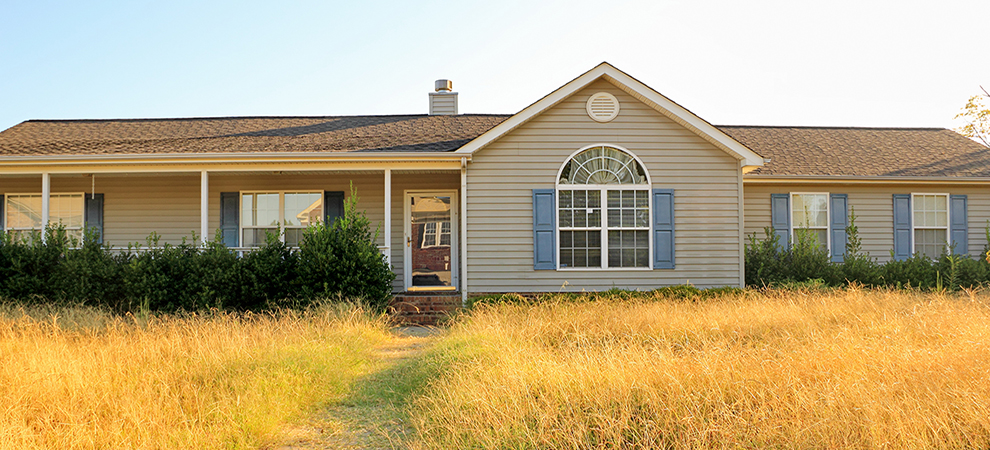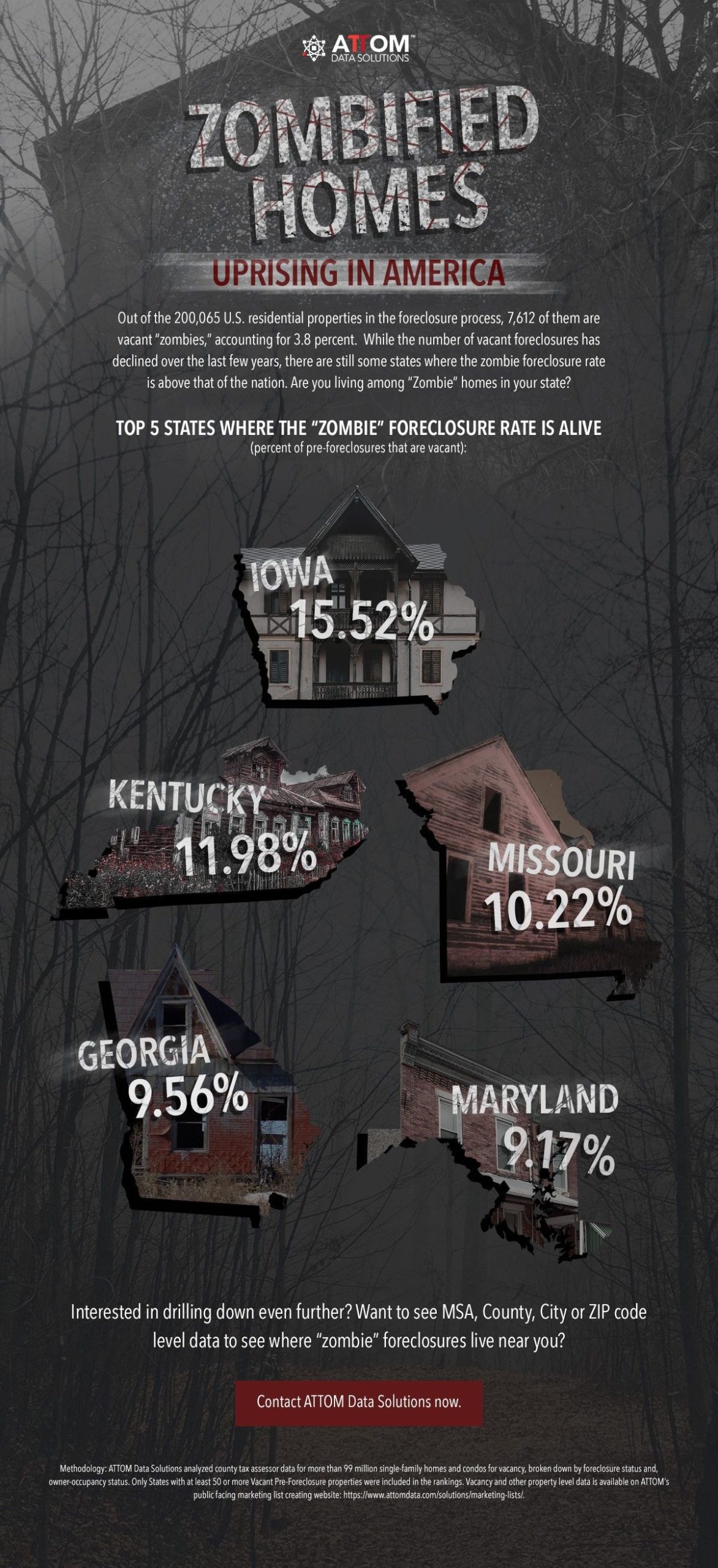The WPJ
THE WORLD PROPERTY JOURNALReal Estate Facts Not Fiction
Residential Real Estate News

Despite COVID Pandemic, Zombie Homes in U.S. Declines in 2020
Residential News » Irvine Edition | By David Barley | October 29, 2020 8:00 AM ET
According to ATTOM Data Solutions fourth-quarter 2020 Vacant Property and Zombie Foreclosure Report, almost 1.6 million (1,556,592) residential properties in the United States, representing 1.6 percent of all homes, are vacant.
The report reveals that 200,065 properties are in the process of foreclosure in the fourth quarter, down 7.3 percent from the third quarter of 2020, while the number sitting empty (7,612) is down 4.4 percent.
The portion of pre-foreclosure properties that have been abandoned into zombie status has ticked up slightly, from 3.7 percent in the third quarter of 2020 to 3.8 percent this quarter.
Among the nation's stock of 99.5 million residential properties, zombie properties continue to represent just a tiny fraction - only one of every 13,100 homes.
The fourth-quarter 2020 data shows a drop in the number of homes at some point in the foreclosure process and virtually the same rate of zombie foreclosures during a time when the federal government continues trying to shield the housing market from an economic slide stemming from the worldwide Coronavirus pandemic. A key measure remains a temporary prohibition against lenders foreclosing on government-backed mortgages. The ban, which is currently in place until December 31 and affects about 70 percent of home loans in the United States, was enacted under the CARES Act passed by Congress in March and then extended to help borrowers who have lost jobs or other sources of income during the pandemic. Some private lenders also have voluntarily offered mortgage extensions.
"Zombie foreclosures have been barely an issue around most of the country for over a year, and they're even less of one now. A surprisingly strong housing market and a temporary ban on foreclosures continues to leave most neighborhoods without a single such property," said Todd Teta, chief product officer with ATTOM Data Solutions. "All that could change in a flash when foreclosures are allowed to resume or if the Coronavirus takes a toll on the market. But for now, things are steady as they go, with the overall numbers down and the rates of zombie properties pretty much unchanged."
Midwest and South have highest zombie foreclosures rates
A total of 7,612 residential properties facing possible foreclosure have been vacated by their owners nationwide in the fourth quarter of 2020. That figure comprises 3.8 percent, or one in 26, of all properties in the foreclosure process. Those numbers are up slightly from 3.7 percent, or one in 27, in the third quarter of 2020, and up from 3 percent, or one in 34 properties, the fourth quarter of 2019.
States with the highest zombie foreclosure rates remain clustered in the Midwest and South. The top rates among states with at least 50 properties in foreclosure and vacant include Iowa (15.5 percent, or one in six properties in the foreclosure process), Kentucky (12 percent, or one in eight), Missouri (10.2 percent, or one in 10), Georgia (9.6 percent, or one in 10), and Maryland (9.2 percent, or one in nine).
"It's worth noting that while foreclosure moratoria have caused the number of zombie properties to drop slightly, the percentage of foreclosure properties in zombie status has increased," said Rick Sharga, executive vice president for RealtyTrac, an ATTOM Data Solutions company. "It's likely that as the length of time it takes to execute a foreclosure continues to increase, we'll also continue to see the percentage of vacant and abandoned foreclosure homes increase."
States with the lowest rates are mostly in the Northeast and West, including Utah (1.3 percent, or one in 76 properties in the foreclosure process), Colorado (1.6 percent, or one in 62), New Jersey (1.7 percent, or one in 61), Idaho (2.2 percent, or one in 47) and California (2.2 percent, or one in 46). (Ratios may differ due to rounding).
Zombie rates rise in all but one state
Zombie-foreclosure rates rose from the third quarter to the fourth quarter of 2020 in 37 states and the District of Columbia. States with at least 100 properties in the foreclosure process and the largest increases include Iowa (up from 10.3 percent to 15.5 percent of all properties in the foreclosure process), Delaware (up from 3.7 percent to 8 percent), Oregon (up from 5.1 percent to 9.2 percent), Mississippi (up from 8.7 percent to 12.2 percent) and Maryland (up from 7 percent to 9.2 percent).
Highest numbers of zombie properties remain in northeastern and midwestern states
New York continues to have the highest actual number of zombie properties (2,131), followed by Florida (1,027), Illinois (934), Ohio (836), and New Jersey (346). California leads in the West, with 234.
"Some of the states with the highest rate of zombie foreclosure properties are also states that have been among the hardest hit by the COVID-19 pandemic," Sharga noted. "When the government bans on foreclosure activity expire, it wouldn't be a surprise to see the number of defaults in those states increase more rapidly than in other parts of the country, and the number of zombie foreclosure properties rise more dramatically in those states as well."
Northeast and Midwest also have highest ratios of zombie foreclosure as portion of all residential properties
Despite increases in the rates of zombie foreclosures in the fourth quarter of 2020, those properties represent just one in every 13,074 residential properties of all kinds in the United States, including those not facing possible bank takeover.
States with the highest ratios are concentrated in the Northeast and Midwest, led by New York (one in 1,941 properties), Illinois (one in 4,243), Ohio (one in 4,592), Florida (one in 6,757) and New Jersey (one in 7,692). New Mexico has the highest ratio in the West (one in 7,692).
States with the lowest ratios include New Hampshire (one in 155,649 properties), Idaho (one in 142,850), West Virginia (one in 132,594), Vermont (one in 128,439) and Arkansas (one in 127,209).
Other high-level findings from fourth-quarter data:
- Among 158 metropolitan statistical areas with at least 100,000 residential properties and at least 100 properties facing possible foreclosure, the highest zombie rates include Kansas City, MO (17.2 percent of properties in the foreclosure process); Peoria, IL (16.3 percent); Omaha, NE (15 percent); Davenport, IA (13.8 percent) and Cleveland, OH (13.2 percent).
- Aside from Kansas City and Cleveland, major metro areas with at least 500,000 residential properties and the highest zombie foreclosure rates are Baltimore, MD (12.4 percent of foreclosure properties); Portland, OR (11.9 percent) and Atlanta, GA (11.5 percent).
- The lowest rates in metro areas with at least 500,000 properties are in San Francisco, CA (0.8 percent of foreclosure properties); Charlotte, NC (1.4 percent); Denver, CO (1.7 percent); Philadelphia, PA (1.7 percent) and New York, NY (1.8 percent).
- The highest zombie-foreclosure rates among counties with at least 500 properties in foreclosure are in Cuyahoga County (Cleveland), OH (14.9 percent); Broome County (Binghamton), NY (10.8 percent); Onondaga County (Syracuse), NY (10 percent); Summit County (Akron), OH (9.3 percent) and Pinellas County (Clearwater), FL (8.6 percent).
- The lowest rates among counties with at least 500 properties in foreclosure are in Passaic County (Paterson), NJ (0.4 percent); Osceola County (Kissimmee), FL (0.6 percent); Westchester County (White Plains), NY (0.9 percent); Queens County, NY (1 percent) and Kings County (Brooklyn), NY (1.1 percent).
- Among zip codes with at least 100 properties in foreclosure, those where the zombie foreclosure rate exceeds 5 percent remain concentrated in New York, Florida, Ohio and Illinois. Those zip codes with the top percentages remain the same as in the third quarter of 2020: 44108, 44112 and 44105, all in Cleveland, OH, 61604 in Peoria, IL, and 13601 in Watertown, NY.
- The highest levels of vacant investor-owned homes are in Indiana (8.3 percent), Kansas (6.8 percent), Michigan (6.6 percent), Ohio (6.3 percent) and Rhode Island (6.1 percent).
- The highest overall vacancy rates for all residential properties continue to be in Kansas (2.7 percent), Mississippi (2.7 percent), Oklahoma (2.6 percent), Tennessee (2.6 percent) and Indiana (2.5 percent). The lowest continue to be in New Hampshire (0.4 percent), Vermont (0.4 percent), Delaware (0.4 percent), Idaho (0.6 percent) and Colorado (0.7 percent).
Sign Up Free | The WPJ Weekly Newsletter
Relevant real estate news.
Actionable market intelligence.
Right to your inbox every week.
Real Estate Listings Showcase
Related News Stories
Residential Real Estate Headlines
- More Americans Opting for Renting Over Homeownership in 2024
- BLOCKTITLE Global Property Tokenization Platform Announced
- Small Investors Quietly Reshaping the U.S. Housing Market in Late 2024
- Greater Miami Overall Residential Sales Dip 9 Percent in November
- U.S. Home Sales Enjoy Largest Annual Increase in 3 Years Post Presidential Election
- U.S. Housing Industry Reacts to the Federal Reserve's Late 2024 Rate Cut
- U.S. Home Builders Express Optimism for 2025
- Older Americans More Likely to Buy Disaster-Prone Homes
- NAR's 10 Top U.S. Housing Markets for 2025 Revealed
- U.S. Mortgage Delinquencies Continue to Rise in September
- U.S. Mortgage Rates Tick Down in Early December
- Post Trump Election, U.S. Homebuyer Sentiment Hits 3-Year High in November
- Global Listings Aims to Become the Future 'Amazon of Real Estate' Shopping Platform
- Greater Las Vegas Home Sales Jump 15 Percent in November
- Ultra Luxury Home Sales Globally Experience Slowdown in Q3
- World Property Exchange Announces Development Plan
- Hong Kong Housing Market to Reach Equilibrium in Late 2025
- Construction Job Openings in U.S. Down 40 Percent Annually in October
- U.S. Mortgage Applications Increase in Late October
- World Property Markets, World Property Media to Commence Industry Joint-Venture Funding Rounds in 2025
- New Home Sales Hit 2 Year Low in America
- U.S. Pending Home Sales Increase for Third Consecutive Month in October
- Pandemic-led Residential Rent Boom is Now Fizzling in the U.S.
- Emerging Global Real Estate Streamer WPC TV Expands Video Programming Lineup
- 1 in 5 Renters in America Entire Paycheck Used to Pay Monthly Rent in 2024
- U.S. Home Sales Jump 3.4 Percent in October
- Home Buyers Negotiation Power Grows Amid Cooling U.S. Market
- Canadian Home Sales Surge in October, Reaching a Two-Year High
- Greater Orlando Area Home Sales Continue to Slide in October
- U.S. Mortgage Credit Availability Increased in October
- U.S. Mortgage Rates Remain Stubbornly High Post Election, Rate Cuts
- Construction Input Prices Continue to Rise in October
- BETTER MLS: A New Agent and Broker Owned National Listings Platform Announced
- Home Prices Rise in 87 Percent of U.S. Metros in Q3
- Caribbean Islands Enjoying a New Era of Luxury Property Developments
- The World's First 'Global Listings Service' Announced
- Agent Commission Rates Continue to Slip Post NAR Settlement
- Market Share of First Time Home Buyers Hit Historic Low in U.S.
- Greater Palm Beach Area Residential Sales Drop 20 Percent Annually in September
- Mortgage Applications in U.S. Dip in Late October
Reader Poll
Marketplace Links
This website uses cookies to improve user experience. By using our website you consent in accordance with our Cookie Policy. Read More






